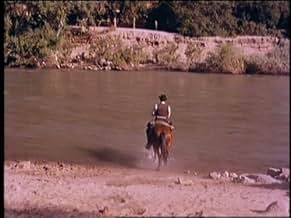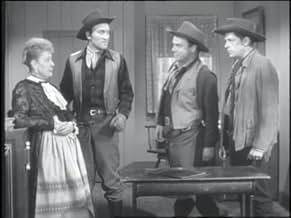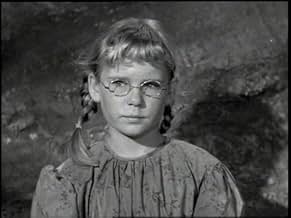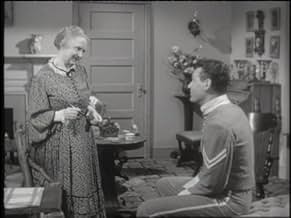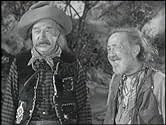Ajouter une intrigue dans votre langueThe adventures of the masked Texas Ranger and his Native American partner.The adventures of the masked Texas Ranger and his Native American partner.The adventures of the masked Texas Ranger and his Native American partner.
- Nommé pour 2 Primetime Emmys
- 3 nominations au total
Avis à la une
There can be no denying that The Lone Ranger is the quintessential TV Western of the 1950s. It is the one show that has proved, time and again, to be a real favorite of both children and adults alike.
Starring Clayton Moore, as the masked rider, and Jay Silverheels, as Tonto, his ever-loyal sidekick, The Lone Ranger was an action-packed, half-hour program whose episodes always had an interesting and thoughtful story to tell about life in the days of the Old West.
Actor Clayton Moore was the absolute embodiment of this mysterious, masked crime-fighter who would often go to great lengths to see that justice was done and that the criminals paid a dear price for their dishonest deeds.
Clayton Moore was once quoted as saying that he had "fallen in love with being the Lone Ranger character".
The Lone Ranger's story concerns a nameless Texas Ranger who is the sole survivor of a vicious ambush. After he is nursed back to health by his new-found comrade, Tonto, he embarks on a mission to bring justice and peace to the lawlessness of the Old West.
Using the benefits from a secret silver mine, the Lone Ranger rides the West on his magnificent horse, Silver, and dispenses justice in the form of his trademark - The silver bullet.
Following the cancellation of The Lone Ranger in 1957, Clayton Moore then embarked on a 40-year career making personal appearances, TV guest spots, and classic TV commercials dressed up as the legendary masked man.
In 1999 Moore died of a heart attack. He was 85 years old.
As an adult and watching the earliest episodes, it occurred to me that Tonto, actually gave all the idea's for his partners image. It was Tonto that suggested the mask. It was Tonto that suggested the silver bullets, and it was Tonto that came up with the name for Silver..when he proclaimed that the horse the Lone Ranger saved from death was "Silver White"! At last, as Tonto stood with the lone surviving Ranger over the graves of the others, Tonto, proclaimed "You are all alone now..You Lone Ranger! Of course, the response was "Yes Tonto, I am..The Lone Ranger!
The bonds of friendship and trust for the Lone Ranger and Tonto, was used 25 years later as an example of true friendship in an episode of Happy Days. In this particular episode, where Ritchie wanted to expose Fonzie for hating liver. The remark from Fonzie that typified what a true friendship should be was this "Many people tried to remove the mask of the Lone Ranger, but Tonto "never tried". All of America knew and felt that the truest of friendships would be to be like The Lone Ranger and Tonto.
Clayton Moore and Jay Silverheels are beloved for more than just being actors in a great western that will live forever. They are symbolic of so much more and as I said..will always be my hero's.
And in this there is no disgrace. The Radio Series and the Television Series, along with some Movie Serials, Feature Films, Syndicated Newspaper Comic Strip and Comic Books, all did their part to make "the Masked Man of the Plains and his Faithful Indian companion, Tonto" a deeply seeded element of our collective psyche and of our literary folklore.
As with most legends, it all started gradually, first with a series of Radio Plays, written for local use in Detroit over Radio Station WXYZ. The Creator was one George W. Trendle and the Principal Writer on the Series was Mr. Trendle's brother-in-law, Mr. Fran Striker. The year was 1933 when the Ranger first rode out to " the Plains of the Early Western United States!" The Lone Ranger, Tonto and the Radio Series all successfully guided Depression Era Americans through the mid and late '30's up to and through World War II. But the Post-War Era found the country in the midst of a Super-Nova Explosion of invention and technology. There had been a new communications medium standing ready in the wings, but unable to go forth until both VE Day and VJ Day had been achieved. Once these were accomplished and the World and America was ready to settle down to both Peace and Prosperity. The "New Technology" was, of course was TELEVISION! And we would surely need something else than "Roller Derby" and "Wrestling From Marigold Arena" to fill up the broadcast hours. And while at first, the time that a TV Station had anything on, except that portrait of that Mohican Chief (Test Pattern, Schultz!) Very soon and with post haste, the Networks began tapping their existing Natural Resources, their existing programming! Virtually all would be ripe for adaptation to the TV Screen.
So, the folks over at Lone Ranger, Incorporated were very interested when Producers Jack Chertok, Harry Poppe, Sherman Harris and Jack Wrather all approached them with a deal to put The Masked Man and Tonto on the Television waves, as well as the Radio.
Immediately they went to work and gave us the first season, which made use of the considerable back log of Radio Dramas, all potentially adaptable to TV dramas. They cast Clayton Moore, a fine supporting actor in many a feature film, and with about a dozen years experience. He also had done some work in Serials over at Republic Pictures' "Thrill Factory", which would be invaluable experience in doing "THE LONE RANGER". Cast as his "faithful Indian companion" and partner in bringing Justice to various parts of the Frontier, we had sheer perfection in character-supporting Actor, Jay Silverheels.** We must mention that there was that rift in about '53, when Clayton Moore walked and was replaced with John Hart. After a season or so, Mr. Moore was back in-having been missed so much! Now, Back to Our Story!! The first years of filming gave the episodes a look and a sound all of their own. They made good use of off screen Narrator, which gave these shows a feel of authenticity and an individual, stand-out one of a kind series. The actors employed were all veterans of the movies of the late silent era thru the 1930's and 1940's. A lot of them had been just about exclusively "Cowboy Movie" players. A good example of these is the casting of Glenn Strange (Bartender Sam on "GUNSMOKE") as the vicious, murderous Gang Leader, Butch Cavandish. And it was the Cavendish Gang's massacre of the Texas Rangers that led to the origin of John Reid (thought to have been slain with the other Texas Rangers) as the "LONE RANGER".
In addition to the old timers in the cast, you will find a lot of new and up and coming talent (then) in the cast. We see people like Phyllis Coates, Dwayne Hickman, Denver Pyle and others in the cast from week to week. All of this, along with an always calling for fair-play, justice and peace in a western world.
The last couple of seasons brought some big changes. First was the use of Colour Filming. That made no difference as a Colour TV Set was still a long way off for our household. The second was a new set of musical themes and queues. (Other than Rossini's Finale from "U NO Wutt!") The new music was never a big deal to us, as we preferred the "old Radio" stock stuff.
With this series and two Feature Films done during this period, THE LONE RANGER (Warner Brothers, 1956) and THE LONE RANGER AND THE LOST CITY OF GOLD (United Artists, 1958), the character has been permanently and indelibly impressed in our identity as a People, we Americans!
Most of the credit for the show's success goes to its leads, Clayton Moore and Jay Silverheels. They became the Lone Ranger and Tonto, lived the roles as no other actors before or since. Moore, in particular, knew the Ranger was presented as a hero and an example to children, and from what I've heard, he tried his best to live up to that. He made the Ranger a fair and just man, someone who didn't judge, who gave people the benefit of the doubt, but acted correctly when the time was right. He used violence only as a last resort. He was a symbol of honor and integrity, the kind of person I wish I could be.
As for Tonto... It occurs to me nowadays how great an actor Jay Silverheels was. Critics of the show always want to use Tonto as the stereotypical ignorant savage, but you have to look at all the things Tonto does. Tonto tracks, takes care of the Ranger when he's wounded, spies out information - you can tell from the expressions on Silverheels' face that there's a lot more going on inside Tonto's head than he lets on. Don't let the broken English fool you!
The thing that really impresses me about `The Lone Ranger' now is how much of a partnership these two characters have. Tonto is not the Ranger's subordinate - they are friends, equals in their adventures. That, as much as any lesson taught in any episode, is what draws me back to the series after so many years: a tried and true friendship.
Oh, if only the Lone Ranger could ride again.
Along with William Boyd's Hopalong Cassidy TV series, which was first telecast on NBC on June 24, 1949, it was among the earliest TV western series. Hopalong Cassidy actually debuted in 1948, when Boyd syndicated his films to NBC. (In 1947, Boyd had bought to the rights to his Hoppy films.)
Fran Stiker and George W. Trendle created the Lone Ranger as a local radio program in 1933. It quickly went nationwide and was the cornerstone of the old Mutual Radio network. Ironically, Hopalong Cassidy was also a Mutual radio program.
When The Lone Ranger was brought to TV in 1949, many of the radio plays were adapted to the younger medium. As a consequence, many of the earliest episodes show their radio origins with the use of a narrator who links the different scenes together. The Lone Ranger was the biggest hit on the new ABC network in its early years.
The first three episodes told the the familiar story of how the Lone Ranger came to be, his connection to Tonto, and the origins of his prize horse Silver. Glenn Strange played the villain Butch Cavandish in these episodes.
The Lone Ranger was also one of the earliest shows to film mostly outdoors. Starting in 1956, the Wrather Company began filming the program in color.
The Cisco Kid, starring Duncan Renaldo and Leo Carrillo had been filmed in color since its first aired in 1950. Jack Wrather, however, was more concerned about the competition to his kid's show from the new adult westerns that had began to appear on TV.
When the Lone Ranger appeared, The New York Times critic Jack Gould ripped the show, as "just another Western, and not a notably good one at that." Gould considered the first three episodes manipulative, mostly because of the cliffhanger endings of the first two episodes. The New York Times writer accused everyone associated with the program of keeping children "emotionally hopped upped." As a result of his criticisms, the cliffhanger type endings were never used after the first two episodes. Gould, however, had been suffering from a misunderstanding. The show had never intended to be broadcast as a serial despite the serial background of its star Clayton Moore.
In 1952, B-film actor John Hart replaced Clayton Moore. Moore had threatened to quit after 1950. He was being paid only $500 an episode for his hit show, and wanted a substantial raise. Audiences rejected Hart in the role, and after 36 episodes Moore was back atop Silver.
The Lone Ranger was the first Western Hit on TV.
The series was filmed in both Utah and in California.
Le saviez-vous
- AnecdotesThe Lone Ranger's young nephew, Dan Reid, who appeared occasionally on this show, was the father of Britt Reid, The Green Hornet. Both characters were created for radio by George W. Trendle.
- GaffesIn the series opening used in syndication, the Lone Ranger is seen riding past rows of trees planted as wind breaks. This practice did not come into use until after the "dust bowl" windstorms of the 1930s.
- Citations
[first lines for each episode]
Narrator: The Lone Ranger!
[gunshots are fired]
The Lone Ranger: Hi-yo, Silver!
Narrator: A fiery horse with the speed of light, a cloud of dust and a hearty "Hi-yo Silver" - the Lone Ranger!
The Lone Ranger: Hi-yo, Silver, away!
Narrator: With his faithful Indian companion, Tonto, the daring and resourceful masked rider of the plains led the fight for law and order in the early West. Return with us now to those thrilling days of yesteryear. The Lone Ranger rides again!
- Versions alternativesThe first three episodes are available edited together as a ersatz feature "Enter the Lone Ranger" (1949) running 68 minutes minus titles and recaps.
- ConnexionsEdited into The Legend of the Lone Ranger (1952)
- Bandes originalesWilliam Tell Overture: Finale
(uncredited)
Written by Gioachino Rossini
[Played at program opening and during closing credits]
Meilleurs choix
- How many seasons does The Lone Ranger have?Alimenté par Alexa
Détails
- Date de sortie
- Pays d’origine
- Langue
- Aussi connu sous le nom de
- El llanero solitario
- Lieux de tournage
- Sociétés de production
- Voir plus de crédits d'entreprise sur IMDbPro
- Durée30 minutes
- Rapport de forme
- 1.33 : 1
Contribuer à cette page




